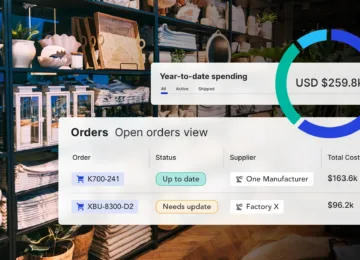Supplier relationship management, or SRM, has always been a key part of ensuring that parts and supplies arrive just in time to meet production needs. Still, the past few years’ events have shown that some disruptions can cripple entire industries. This article serves as a overview of what SRM integration looks like in supply chain management, including its benefits, essential integration system types, and a SRM case study featuring our customer, Native.
What Is Supplier Relationship Management?
Similar to the theory of customer relationship management, or CRM, supplier relationship management (SRM) is a systematic approach to evaluating and managing vendors. It seeks to determine their unique value in the procurement chain for goods, materials, and services and develop strategies to improve performance and build mutually beneficial relationships.
Effective SRM is a form of risk management that identifies a strategic supplier or key suppliers. It then seeks to develop initiatives that improve the processes that take place between the supplier and the buyer, based on their importance to the organization.
It is generally believed that the concept of SRM first became recognized in a 1983 Harvard Business Review article titled “Purchasing Must Become Supply Management,” by Peter Kraljic. In the article, Kraljic states that “Ensuring the long-term availability of critical materials and components at competitive cost calls for nothing less than a total change of perspective: from purchasing (an operating function) to supply management (a strategic one).”
In a May 2021 article exploring supply chains and their strategic importance as part of the post-COVID response, Deloitte notes that the major problem in supply chain management levers is that so little is known about how external networks can make the supply chain vulnerable. Their CPO survey finds that “only half of procurement functions have high visibility over Tier 1 suppliers, while 90% had moderate to very low extended supply network visibility.”
Improving supplier performance management generally involves the following steps:
- Segment suppliers: This segmentation involves identifying all the suppliers and categorizing them by their importance to the business. Supplier segmentation aims to develop a supplier strategy, ensuring that key suppliers receive the appropriate amount of attention.
- Develop a strategic supplier strategy: Next, develop an SRM strategy to work with these key suppliers. This category management approach involves creating business processes and establishing performance management models to align stakeholders with business goals.
- Implement the supplier strategy: Then, put the standardized procurement strategy into action on a day-to-day basis.
- Measure, analyze and revise: Use SRM software to understand suppliers, assess whether gaps exist in supply processes, and establish performance standards. Finally, create a risk management approach that includes set policies, addresses associated risks, and improves outcomes with the designated suppliers.
Why SRM Is Crucial in Supply Chain Management
The world is changing rapidly, and it can be difficult to predict when something will happen that interferes with the ability to obtain needed supplies. The global chip shortage, Suez Canal blockage, and shortage of food supplies from Ukraine are just a few glaring examples of what can happen when key suppliers cannot provide sufficient supply to meet demand.
SRM is essential in supply chain management processes to track any number of key interactions with providers, including:
- Stronger supplier management operations
- Contract management
- Supplier contact and data management
- Communication histories
- Purchase order, requisition, and invoice histories
- Production and shipping schedules
- Inventory management
- Supplier performance management and performance analytics against key metrics
- Supplier risk management
- Product specifications and lifecycle management
Benefits of SRM
Supplier relationship management (SRM) allows a business to increase efficiency in its supply chain management and sourcing process. Benefits of implementing a successful supplier strategy include:
Lower Expenses
Creating a more agile business that can adapt to supply chain network changes leads to cost savings to the bottom line, and a resultant increase in profitability. Automating the purchasing lifecycle through SRM software reduces reliance on manual processes and helps streamline project management. As risk mitigation improves within the organization, the company can also create a stronger cash flow.
More Reliability and Trust
A company that shows its desire to create better relationships with suppliers is more likely to build increased trust. This starts with the supplier onboarding process, as the purchasing manager can outline exactly what is expected of new suppliers.
Greater Production and Process Efficiency
The SRM process allows the organization to get better quality control with products and raw materials throughout the procurement process. Better shipping and warehousing measures lead to reduced inventory and overhead costs. By using state-of-the-art supply chain software, businesses can achieve better visibility into their operations with improved supplier data and real-time analytics.
SRM Case Study: Utilizing Supply Chain Software for Success
Anvyl allows supply chain technology to collaborate for business by providing insights to make intelligent, better-informed decisions. These case studies highlight the use of supply chain initiatives in action:
Native
As a company dedicated to simple, clean personal care products and an eco-friendly approach to production, Native wanted to align stakeholders for its new plastic-free packaging initiatives without accompanying time-to-market delays. Their goals were to align the supply chain team, manage production timelines, launch an eco-friendly packaging line, and create new product categories. Using Anvyl, Native was able to:
- Increase production visibility with digitized POs.
- Streamline communication, ERP integration, and logistics tracking.
- Improve productivity through better sourcing for eco-friendly packaging
- Automate milestone updates.
- Boost managed SKUs by 8x and monthly active managed orders by 5x.
Case study results show 99.5% supplier engagement, 45% reduced per-unit costs, four months speed to market, 100% shipments linked to POs, 80% reduced tooling costs, and 0 added headcount.
Enhance Your SRM Strategy With Anvyl
Any supplier relationship management strategy can be improved with supply chain management software.
Ready to learn more? Our team has extensive experience in helping our customers manage their supply chains. Schedule a demo and learn more about how we can help you centralize data, automate processes, and drive collaboration across your supply chain.



